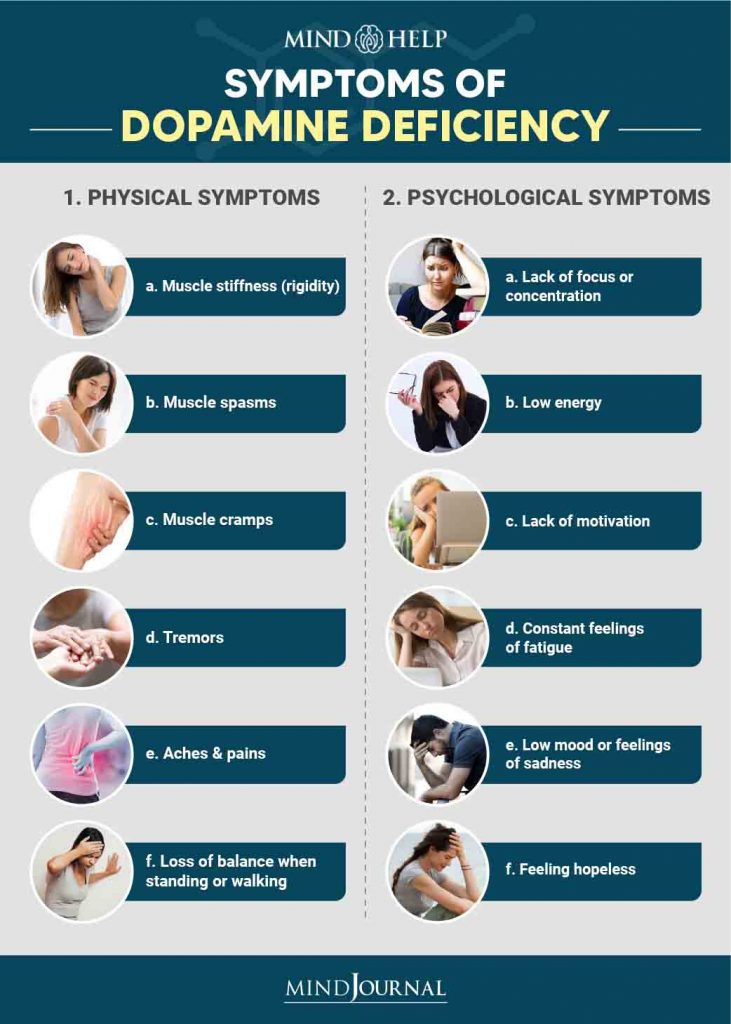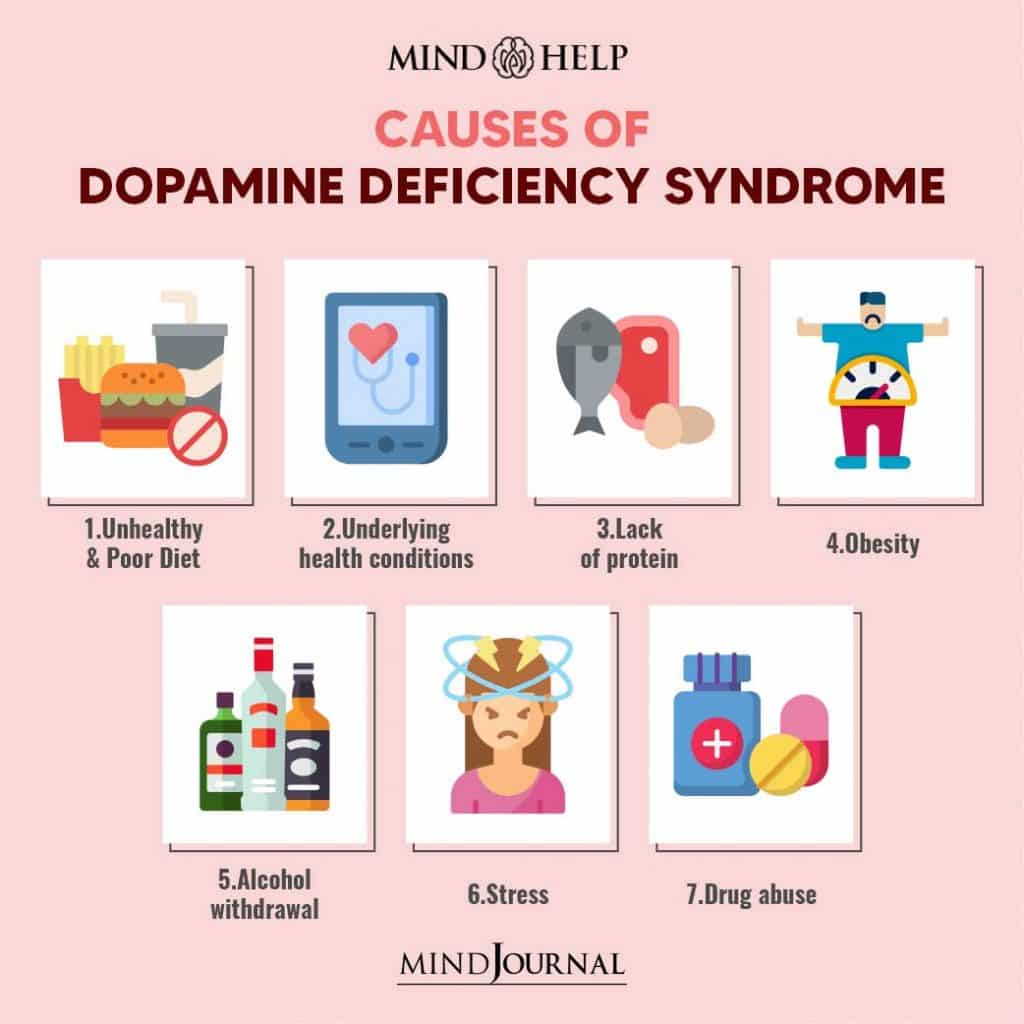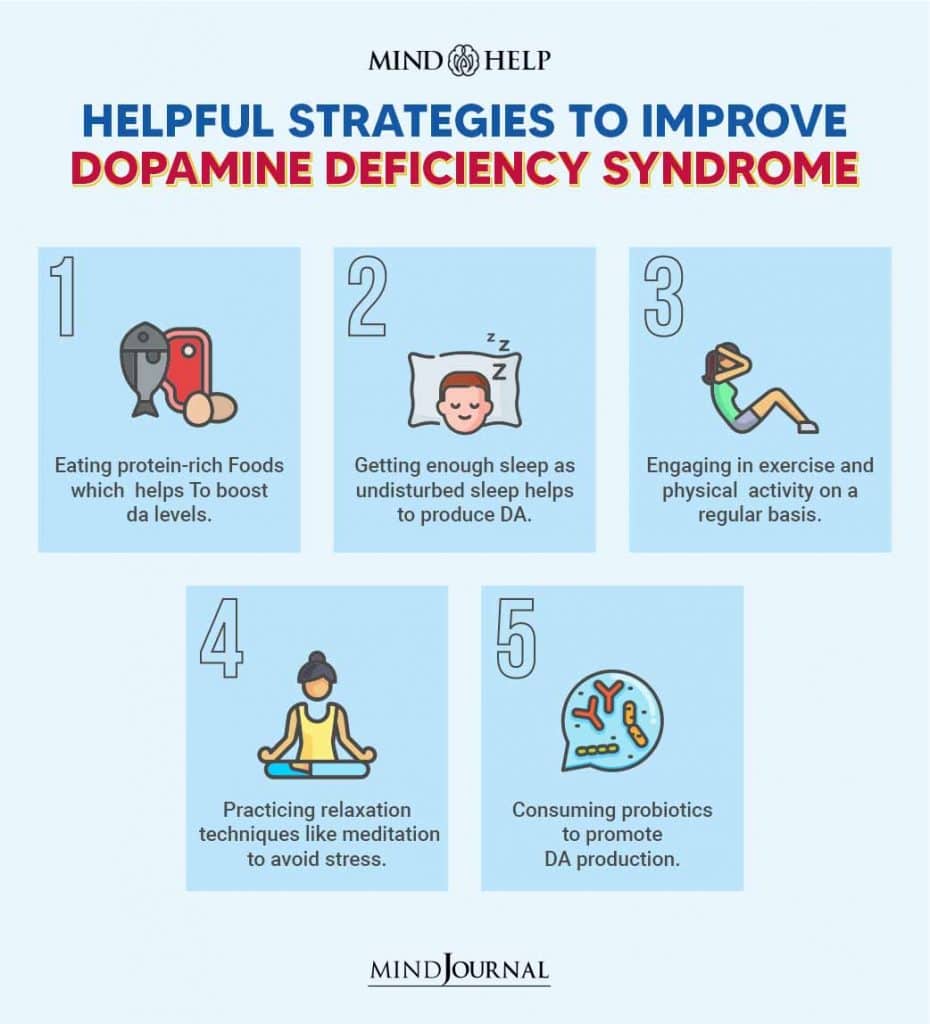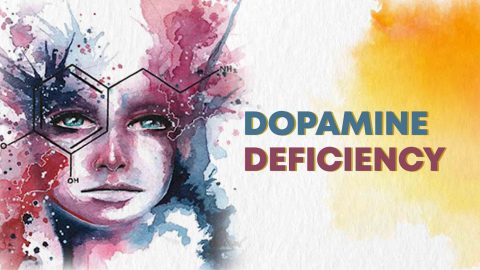Table of Contents
Dopamine deficiency refers to low levels of dopamine in the brain which can adversely affect our emotional responses and movements. This can cause dopamine deficiency syndrome, which is a hereditary movement disorder. It is an extremely rare condition.
What Is Dopamine Deficiency?
Dopamine is a neurotransmitter that regulates our motivation, pleasure and reward system. It is also associated with memory, learning and motor system function.
According to a 2016 study 1 Juárez Olguín, H., Calderón Guzmán, D., Hernández García, E., & Barragán Mejía, G. (2016). The Role of Dopamine and Its Dysfunction as a Consequence of Oxidative Stress. Oxidative medicine and cellular longevity, 2016, 9730467. https://doi.org/10.1155/2016/9730467 , “Dopamine (DA) plays a vital role in reward and movement regulation in the brain.”
Researchers from another study 2 Juárez Olguín, H., Calderón Guzmán, D., Hernández García, E., & Barragán Mejía, G. (2016). The Role of Dopamine and Its Dysfunction as a Consequence of Oxidative Stress. Oxidative medicine and cellular longevity, 2016, 9730467. https://doi.org/10.1155/2016/9730467 explain “DA plays multiple functions in the brain.”
However, unbalanced or low levels of dopamine can result in various severe mental and physical health conditions.
Although we may not be able to accurately measure the dopamine levels in our brain, low levels of DA and irregular DA activity can lead to certain symptoms and ailments, such as Parkinson’s disease, attention deficit hyperactivity (ADHD), schizophrenia, depression and addiction.
The indicators of dopamine deficiency may be the following:
- Low production and release of dopamine
- Insufficient dopamine receptors
- Dopamine receptors are malfunctioning or impaired
- Dopamine is not being efficiently recycled
- Dopamine is not being broken down properly
Although dopamine deficiency is not seen as a separate medical diagnosis, it can cause Dopamine deficiency syndrome in some cases, which is a rare medical disorder.
Read More About Dopamine Here
Dopamine Deficiency Syndrome
One of the primary conditions caused by low DA is the Dopamine deficiency syndrome. This rare movement disorder, also known as a Dopamine transporter deficiency syndrome (DTDS) and Infantile Parkinsonism-Dystonia, has been identified as the first inherited dopamine transportopathy 3 Blackstone C. (2009).
Infantile parkinsonism-dystonia: a dopamine “transportopathy”. The Journal of clinical investigation, 119(6), 1455–1458. https://doi.org/10.1172/jci39632 .
“DTDS is a recently described neurotransmitter disease that is classically characterized by an infantile onset, complex progressive motor disorder that is pharmacoresistant and life-limiting,” explains a 2014 study 4 Ng, J., Zhen, J., Meyer, E., Erreger, K., Li, Y., Kakar, N., Ahmad, J., Thiele, H., Kubisch, C., Rider, N. L., Morton, D. H., Strauss, K. A., Puffenberger, E. G., D’Agnano, D., Anikster, Y., Carducci, C., Hyland, K., Rotstein, M., Leuzzi, V., Borck, G., … Kurian, M. A. (2014).
Dopamine transporter deficiency syndrome: phenotypic spectrum from infancy to adulthood. Brain : a journal of neurology, 137(Pt 4), 1107–1119. https://doi.org/10.1093/brain/awu022 on DTDS.
The condition is known to be progressively worsening, early infantile-onset parkinsonism and dystonia. It is regarded as extremely rare as there have been only 20 confirmed patients of DTDS mentioned in medical literature, according to the U.S. National Library of Medicine.
It is believed that this syndrome may be underdiagnosed or misdiagnosed as the symptoms tend to be common with movement disorders, like cerebral palsy. Hence, it is believed that the condition may not be as rare as believed earlier.
DTDS severely affects an individual’s ability to control or move their muscles and body. Generally, the symptoms of this syndrome start to appear in infancy but in some cases they may appear later in life.
As of now, there is no specific cure for DTDS. However, opting for treatment that focuses on managing the symptoms can be helpful in the long term.
Understanding DTDS
Dopamine deficiency syndrome usually develops during infancy and worsens progressively over time. However, sometimes the symptoms may become noticeable only in childhood or later.
Dopamine transporter deficiency syndrome can cause dystonia, which is a condition marked by persistent, involuntary muscle contractions. These contractions often impact various muscle groups, causing continuous spasms and cramps.
This leads to everyday tasks like eating, walking, drinking and even talking with someone become extremely challenging and disruptive. become As a result, everyday tasks like walking, eating, drinking, and even speaking can become extremely difficult and disruptive to daily life.
The affected person may eventually develop parkinsonism as the condition becomes worse. Parkinsonism is characterized by various movement abnormalities may occur, including bradykinesia (unusually slow movements), muscle rigidity, tremors, and postural instability, making it difficult to maintain balance or keep the body upright.
DTDS can adversely affect a person’s lifespan.
However, researchers are yet to identify the long-term effects of this syndrome on the patients.
The development of dopamine deficiency syndrome is regarded as a continuum as it involves early-onset DTDS, where the symptoms arise in the first 6 months; and atypical later-onset DTDS, where onset occurs in childhood, adolescence or even adulthood.
If the symptoms arise later in life, then it may continue into adulthood.
Symptoms Of Dopamine Deficiency

Some of the major and most commons symptoms associated with DA deficiency are the following:
1. Physical symptoms
Here are some general signs of low DA levels in the brain:
- Muscle stiffness
- Muscle cramps
- Bradykinesia (excessive slow movement of muscles)
- Tremors
- Aches and pains
- Muscle spasms
- Constipation
- Weight gain or weight loss
- Restless leg syndrome
- Changes in coordination
- Unmanageable eye movements
- Gastroesophageal reflux disease (GERD)
- Frequent pneumonia
- Trouble swallowing
- Difficulty with eating food
- Difficulty sleeping or disturbed sleep
- Difficulty holding the body in an upright position
- Loss of balance when standing or walking
2. Psychological symptoms
Low levels of DA may also cause the following psychological symptoms as well:
- Difficulty focusing or concentrating
- Persistent low energy levels
- Lack of motivation
- Ongoing fatigue
- Feelings of sadness or a consistently low mood
- Hopelessness
- Frequent and unpredictable mood swings
- Low self-esteem
- Anxiety and restlessness
- Overwhelming feelings of guilt
- Experiencing hallucinations
- Holding false or delusional beliefs
- Limited or absent self-awareness
- Signs of depression
- Problems with working memory
- Inability to experience pleasure (anhedonia)
- Symptoms associated with dementia
- Traits linked to schizophrenia
- Indicators of attention-deficit hyperactivity disorder (ADHD)
- Thoughts of self-harm or suicidal behavior
3. DTDS symptoms
Apart from the common signs of dopamine deficiency, here are some specific symptoms 5 Dopamine transporter deficiency syndrome. Genetics Home Reference (GHR). October, 2015; https://ghr.nlm.nih.gov/condition/dopamine-transporter-deficiency-syndrome. of Dopamine transporter deficiency syndrome (DTDS):
- Parkinsonism
- Elevated carboxylic acid levels in the blood
- Abnormal pyramidal tract signs
- Loss of speech
- Slowness of movement (bradykinesia)
- Cerebral palsy
- Decreased spontaneous movement (hypokinesia)
- Chronic constipation
- Involuntary movements (chorea)
- Reduced facial expression (hypomimia)
- Increased muscle tone in the limbs (limb hypertonia)
- Decreased muscle tone in the trunk (truncal hypotonia)
- Episodes of upward eye deviation (oculogyric crisis)
- Involuntary mouth and facial movements (orofacial dyskinesia)
- Difficulty with feeding
Causes Of Dopamine Deficiency Syndrome

Low levels of Dopamine Deficiency can be a result of a variety of factors such as poor, unhealthy lifestyle of serious health issues.
Some of the common triggers of dopamine deficiency are the following:
- Poor, unhealthy diet and eating habits
- Pre-existing health conditions
- Consuming insufficient protein6
- Obesity
- Alcohol withdrawal
- Stress 6 Moriam, S., & Sobhani, M. E. (2013). Epigenetic effect of chronic stress on dopamine signaling and depression. Genetics & epigenetics, 5, 11–16. https://doi.org/10.4137/GEG.S11016
- Drug abuse
However, the dopamine transporter deficiency syndrome (DTDS) is believed to be caused by various factors, some of which are mentioned below:
1. Mutations in the SLC6A3 gene
Researchers believe that DTDS may be caused by the SLC6A3 gene 7 Kurian MA. SLC6A3-Related Dopamine Transporter Deficiency Syndrome. 2017 Jul 27. In: Adam MP, Ardinger HH, Pagon RA, et al., editors. GeneReviews® [Internet]. Seattle (WA): University of Washington, Seattle; 1993-2021. Available from: https://www.ncbi.nlm.nih.gov/books/NBK442323/ mutations.
This gene promotes the production of the protein known as dopamine transporter (DAT) 8 Torres GE. The dopamine transporter proteome. J Neurochem. 2006 Apr;97 Suppl 1:3-10. doi: 10.1111/j.1471-4159.2006.03719.x. PMID: 16635244. , which is embedded in the membrane of specific neurons or nerve cells in the brain. This helps in transporting DA into the cell which regulates movement control, behavior, motivation and cognition.
Mutations in the SLC6A3 gene lead to functional impairments in the DAT. This leads to a deficiency of functional dopamine transporter and affects DA signaling in our brain.
According to the 2014 study on DTDS, “Dopamine transporter mutants also showed diminished dopamine binding affinity, reduced cell surface transporter, loss of post-translational dopamine transporter glycosylation and failure of amphetamine-mediated dopamine efflux.”
It is yet to be known how dopamine signaling changes cause certain movement abnormalities seen in individuals with DTDS even though dopamine helps to regulate movement.
However, the age of onset is believed to be associated with the intensity of impairment in the function of the dopamine transporter.
2. Autosomal Recessive Inheritance
According to a 2011 study 9 Kurian MA, Li Y, Zhen J, Meyer E, Hai N, Christen HJ, Hoffmann GF, Jardine P, von Moers A, Mordekar SR, O’Callaghan F, Wassmer E, Wraige E, Dietrich C, Lewis T, Hyland K, Heales S Jr, Sanger T, Gissen P, Assmann BE, Reith ME, Maher ER. Clinical and molecular characterisation of hereditary dopamine transporter deficiency syndrome: an observational cohort and experimental study.
Lancet Neurol. 2011 Jan;10(1):54-62. doi: 10.1016/S1474-4422(10)70269-6. Epub 2010 Nov 25. PMID: 21112253; PMCID: PMC3002401. , the inheritance of dopamine deficiency syndrome is autosomal recessive 10 Goldstein, D. Y., & Prystowsky, M. (2017). Autosomal Recessive Inheritance: Cystic Fibrosis. Academic pathology, 4, 2374289517691769. https://doi.org/10.1177/2374289517691769 and is related to impaired dopamine transporter function.
The researchers explain “dopamine transporter deficiency syndrome is the first identified parkinsonian disorder caused by genetic alterations of the dopamine transporter.” Autosomal recessive is a pattern in which a disorder is passed down among first-degree family members.
An autosomal recessive pattern indicates that two copies of the gene mutations must be present for the disorder to develop. Each parent of the affected person with the autosomal recessive disease carries one copy of the abnormal gene.
However, the parents usually do not show any symptoms of the disorder. According to a 2017 study 11 Yildiz Y, Pektas E, Tokatli A, Haliloglu G. Hereditary Dopamine Transporter Deficiency Syndrome: Challenges in Diagnosis and Treatment. Neuropediatrics. 2017 Feb;48(1):49-52. doi: 10.1055/s-0036-1593372. Epub 2016 Sep 30. PMID: 27690368. , “Hereditary dopamine transporter deficiency syndrome (DTDS) is a neurotransmitter disorder caused by a defect in the neuronal uptake of dopamine.”
Other Conditions Associated With Dopamine Deficiency
Apart from DTDS, low levels of dopamine can also cause a range of other mental and physical health issues.
Studies 12 Drozak J, Bryła J. Dopamina–nie tylko neuroprzekaźnik [Dopamine: not just a neurotransmitter]. Postepy Hig Med Dosw (Online). 2005;59:405-20. Polish. PMID: 16106242. show that dopamine deficiency is associated with a number of different psychiatric and neurological disorders, such as Parkinson’s Disease 13 Mishra, A., Singh, S., & Shukla, S. (2018). Physiological and Functional Basis of Dopamine Receptors and Their Role in Neurogenesis: Possible Implication for Parkinson’s disease.
Journal of experimental neuroscience, 12, 1179069518779829. https://doi.org/10.1177/1179069518779829 , Alzheimer’s disease 14 Martorana, A., & Koch, G. (2014). “Is dopamine involved in Alzheimer’s disease?”. Frontiers in aging neuroscience, 6, 252. https://doi.org/10.3389/fnagi.2014.00252 , schizophrenia and drug addiction, such as cocaine and amphetamine.
Low DA function is also related to Huntington’s disease and attention deficit hyperactivity (ADHD) 15 Wu J, Xiao H, Sun H, Zou L, Zhu LQ. Role of dopamine receptors in ADHD: a systematic meta-analysis. Mol Neurobiol. 2012 Jun;45(3):605-20. doi: 10.1007/s12035-012-8278-5. Epub 2012 May 19. PMID: 22610946. .
A 2019 study 16 Klein MO, Battagello DS, Cardoso AR, Hauser DN, Bittencourt JC, Correa RG. Dopamine: Functions, Signaling, and Association with Neurological Diseases. Cell Mol Neurobiol. 2019 Jan;39(1):31-59. doi: 10.1007/s10571-018-0632-3. Epub 2018 Nov 16. PMID: 30446950. explains that dopamine signaling pathways are potentially involved “in evoking the onset and progression of some diseases in the nervous system, such as Parkinson’s, Schizophrenia, Huntington’s, Attention Deficit and Hyperactivity Disorder, and Addiction.”
Studies 17 Wang GJ, Volkow ND, Logan J, Pappas NR, Wong CT, Zhu W, Netusil N, Fowler JS. Brain dopamine and obesity. Lancet. 2001 Feb 3;357(9253):354-7. doi: 10.1016/s0140-6736(00)03643-6. PMID: 11210998. reveal that dopamine deficiency is also linked with obesity and pathological eating. Researchers 18 Wang GJ, Volkow ND, Fowler JS. The role of dopamine in motivation for food in humans: implications for obesity.
Expert Opin Ther Targets. 2002 Oct;6(5):601-9. doi: 10.1517/14728222.6.5.601. PMID: 12387683. believe that “low brain DA activity in obese subjects predisposes them to excessive use of food.”
Low DA levels also increase the risk of a number of mental health disorders schizophrenia, depression and addiction. According to a 2014 study 19 Brisch, R., Saniotis, A., Wolf, R., Bielau, H., Bernstein, H. G., Steiner, J., Bogerts, B., Braun, K., Jankowski, Z., Kumaratilake, J., Henneberg, M., & Gos, T. (2014). The role of dopamine in schizophrenia from a neurobiological and evolutionary perspective: old fashioned, but still in vogue.
Frontiers in psychiatry, 5, 47. https://doi.org/10.3389/fpsyt.2014.00047 found that dopamine abnormalities have been found to be involved in schizophrenia. Research 20 Brown AS, Gershon S. Dopamine and depression. J Neural Transm Gen Sect. 1993;91(2-3):75-109. doi: 10.1007/BF01245227. PMID: 8099801. also shows that DA levels also play a significant role in depression.
A 2017 study 21 Belujon, P., & Grace, A. A. (2017). Dopamine System Dysregulation in Major Depressive Disorders. The international journal of neuropsychopharmacology, 20(12), 1036–1046. https://doi.org/10.1093/ijnp/pyx056 in major depressive disorder and anhedonia revealed that “Anhedonia is considered a core feature of major depressive disorder, and the dopamine system plays a pivotal role in the hedonic deficits described in this disorder.”
Scientists have also found that dopamine deficiency has a strong influence on addiction and addictive behaviors as well. “As a result of habitual intake of addictive drugs, dopamine receptors expressed in the brain are decreased,” explains a recent study.
Diagnosis Of Dopamine Deficiency Syndrome
Diagnosing dopamine deficiency can be challenging, primarily because there’s no reliable way to directly measure dopamine levels in the brain. This difficulty is compounded when dealing with rare genetic disorders, which are often complex to identify.
However, healthcare professionals use a combination of tools to assess potential dopamine imbalances. These include evaluating a patient’s medical and family history, lifestyle factors, symptoms, as well as conducting physical exams and lab tests.
While blood tests can measure dopamine levels, they don’t reflect how the brain is responding to dopamine. For a more detailed assessment, doctors may analyze cerebrospinal fluid to detect certain acids related to dopamine metabolism.
This process is known as creating a neurotransmitter profile. In cases of suspected Dopamine Transporter Deficiency Syndrome (DTDS), blood samples can also be tested for genetic markers.
Additionally, the Genetic Testing Registry (GTR) provides valuable information on available genetic tests for diagnosing DTDS.
Because dopamine levels can be influenced by various underlying health conditions, doctors often prioritize symptom evaluation over direct dopamine testing. If you suspect you might have a dopamine deficiency, it’s important to consult a medical professional.
While there may not be a specific cure, the symptoms of dopamine deficiency can often be effectively managed with the right treatment and support.
Treatment Of Dopamine Deficiency Syndrome
There is no standardized or established treatment plan for DTDS. The doctor needs to work closely with the patient to determine what treatment approach and medications may work through trial and error.
According to studies 22 Kurian, M. A., Li, Y., Zhen, J., Meyer, E., Hai, N., Christen, H. J., Hoffmann, G. F., Jardine, P., von Moers, A., Mordekar, S. R., O’Callaghan, F., Wassmer, E., Wraige, E., Dietrich, C., Lewis, T., Hyland, K., Heales, S., Jr, Sanger, T., Gissen, P., Assmann, B. E., … Maher, E. R. (2011). Clinical and molecular characterisation of hereditary dopamine transporter deficiency syndrome: an observational cohort and experimental study.
The Lancet. Neurology, 10(1), 54–62. https://doi.org/10.1016/S1474-4422(10)70269-6 , other movement disorders, such as Parkinson’s disease, which are also related to dopamine production, can be effectively treated with levodopa (L-Dopa) 23 Gandhi KR, Saadabadi A. Levodopa (L-Dopa) [Updated 2020 Oct 27]. In: StatPearls [Internet]. Treasure Island (FL): StatPearls Publishing; 2020 Jan-. Available from: https://www.ncbi.nlm.nih.gov/books/NBK482140/ , the precursor to dopamine, to relieve symptoms.
Researchers have used the dopamine antagonists pramipexole 24 Singh R, Parmar M. Pramipexole. [Updated 2020 Dec 2]. In: StatPearls [Internet]. Treasure Island (FL): StatPearls Publishing; 2020 Jan-. Available from: https://www.ncbi.nlm.nih.gov/books/NBK557539/ and ropinirole 25 Rewane A, Nagalli S. Ropinirole. [Updated 2020 Jul 6]. In: StatPearls [Internet]. Treasure Island (FL): StatPearls Publishing; 2020 Jan-. Available from: https://www.ncbi.nlm.nih.gov/books/NBK554532/ to treat dopamine deficiency syndrome as these medications help to relieve symptoms of Parkinson’s disease in adults.
Although there has been some success, further research is necessary to understand the long-term and short-term side effects.
Apart from medications, counseling and physical therapy to improve movement difficulties and muscle stiffness can be effective as well. Moreover, certain lifestyle and diet changes can also help to improve dopamine in the body and relieve the symptoms.
Some helpful strategies to overcome dopamine deficiency are:

- Eating protein-rich foods, like fish, meat, eggs, dairy, soy, legumes, nuts and seeds, as the amino acid tyrosine 26 Fernstrom JD, Fernstrom MH. Tyrosine, phenylalanine, and catecholamine synthesis and function in the brain. J Nutr. 2007 Jun;137(6 Suppl 1):1539S-1547S; discussion 1548S. doi: 10.1093/jn/137.6.1539S. PMID: 17513421. helps to boost DA levels.
- Avoiding consuming foods that are high in saturated fat and sugar.
- Getting enough sleep as undisturbed sleep 27 Korshunov, K. S., Blakemore, L. J., & Trombley, P. Q. (2017). Dopamine: A Modulator of Circadian Rhythms in the Central Nervous System. Frontiers in cellular neuroscience, 11, 91. https://doi.org/10.3389/fncel.2017.00091 helps to produce DA.
- Engaging in exercise 28 Lin, T. W., & Kuo, Y. M. (2013). Exercise benefits brain function: the monoamine connection. Brain sciences, 3(1), 39–53. https://doi.org/10.3390/brainsci3010039 and physical activity on a regular basis.
- Practicing relaxation techniques like meditation 29 Krishnakumar, D., Hamblin, M. R., & Lakshmanan, S. (2015). Meditation and Yoga can Modulate Brain Mechanisms that affect Behavior and Anxiety-A Modern Scientific Perspective. Ancient science, 2(1), 13–19. https://doi.org/10.14259/as.v2i1.171 to avoid stress.
- Consuming probiotics 30 Sarkar, A., Lehto, S. M., Harty, S., Dinan, T. G., Cryan, J. F., & Burnet, P. (2016). Psychobiotics and the Manipulation of Bacteria-Gut-Brain Signals. Trends in neurosciences, 39(11), 763–781. https://doi.org/10.1016/j.tins.2016.09.002 to promote DA production.
- Listening to instrumental music 31 Ferreri L, Mas-Herrero E, Zatorre RJ, Ripollés P, Gomez-Andres A, Alicart H, Olivé G, Marco-Pallarés J, Antonijoan RM, Valle M, Riba J, Rodriguez-Fornells A. Dopamine modulates the reward experiences elicited by music. Proc Natl Acad Sci U S A. 2019 Feb 26;116(9):3793-3798. doi: 10.1073/pnas.1811878116. Epub 2019 Jan 22. PMID: 30670642; PMCID: PMC6397525. to promote dopamine release in the brain.
- Taking vitamin 32 Guilarte TR. Effect of vitamin B-6 nutrition on the levels of dopamine, dopamine metabolites, dopa decarboxylase activity, tyrosine, and GABA in the developing rat corpus striatum. Neurochem Res. 1989 Jun;14(6):571-8. doi: 10.1007/BF00964920. PMID: 2761676. and mineral supplements.
However, it’s important to note that there is no solid evidence to support the idea that dietary changes or home remedies can effectively treat dopamine deficiency syndrome.
Overcoming Dopamine Deficiency
Dopamine deficiency can lead to various physical and psychiatric health issues, including Dopamine Transporter Deficiency Syndrome (DTDS). Since there is limited evidence supporting the effectiveness of dietary changes or home remedies, the most reliable approach to managing dopamine deficiency is seeking prompt medical care.
If you suspect that you or someone you know may have low dopamine levels, it’s essential to consult a doctor and follow the recommended treatment plan closely. With proper medical intervention, such as prescribed medications and physiotherapy, dopamine deficiency symptoms can be managed and improved over time.
Frequently Asked Questions (FAQs)
1. What are major signs of low dopamine?
The major signs of low dopamine are – lack of motivation, anxiety, mood swings, low sex drive, depression, constant fatigue, sleep disturbances and loss of focus.
2. Does sunlight increase dopamine?
Yes, sunlight has been shown to boost dopamine levels. The skin absorbs sunlight and produces Vitamin D and this process is known to trigger production of dopamine and serotonin.
3. What foods are high in dopamine?
Foods rich in phenylalanine and tyrosine are known to contribute to dopamine production. Foods rich in these amino acids are eggs, fish, pork, diary, beef, chicken, nuts, seeds, bananas and avocados.















